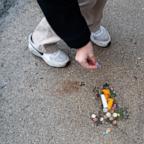Momtroversy: Public potty training, yay or nay?
It's a messy issue.
It's perhaps the second-biggest source of angst in the toddler years, next to a lack of sleep. It's potty training, and opinions on how to get the job done are varied among families.
The issue of public potty training, however, took the throne last week when a photo of a woman sitting her child on a portable potty in an aisle of an airplane went viral.
The vast majority of comments on the Passenger Shaming Facebook page were outspoken against the potty in the aisle. Opinions included: "This is why we need child free flights," and "This act is very disgusting in any public place not to mention closed environment like [an] airplane."
"Good Morning America," asked real-life moms their thoughts on not only the airplane incident but other instances of public potty training. If you're not familiar with the term, imagine you're a few days into potty training and things are going well. You venture out with your little one to the local park. Suddenly, she has to go. Right. Now. There's not a bathroom in sight. What do you do?
Turns out moms who have been there are a lot more sympathetic.
"I am potty training twins and have a 4 month old," Beth Wasik told "GMA." "We are working so hard at it but it is a struggle sometimes. When we are out and about, if one of them has to go 'right now,' sometimes that means right now, and finding a bathroom or waiting for a bathroom means an accident."
"I carry the OXO portable potty out with us wherever we go," she added. "One instance that we had to use it that was less than ideal was on the sidewalk at the zoo. I didn’t want attention, I didn’t feel entitled, and I most certainly didn’t want to expose my child to strangers. But, alas, it was the best option for us and my child. I thought I was doing the right thing in staying consistent with our training."
She added, "In the instance of a plane, when I read this headline my first judgement was not of shock or anger, but understanding. I just assumed, 'oh she must be in the throes of potty training.”'
Aly Chirumbolo was equally as tolerant.
"I personally would not have let my daughter use it in an airplane aisle but I’d never judge that mom for doing it," she said. "I would have tried to get her [the child] to some sort of private place because I’ve learned through my potty training adventures part of what I’m also teaching my daughter besides mechanics is what is socially acceptable behavior, (i.e. we don’t look under stalls, we don’t just pull our pants down anywhere, etc)."
Rebekah Rosler is a mother and the co-founder of Mom MeetUps, a way to connect with other moms and make lasting friendships through social meetups, unique events, educational classes, and Facebook communities. She found herself in a delicate situation last spring when she was in a meeting at the United Nation -- yes, that U.N. with her daughter in tow. It was International Women's Day.
"I was at a meeting at the United Nations in April, and my potty trained 2-year-old -- who was with me -- had to go," Rosler said. "What was I to do? I whipped out the travel potty, and she pooped on the floor, in the U.N. I have a set of 1-year-old twins, and an almost 3 year old. There are certain circumstances that are dire."
So what do the potty training experts say?
Adriana Vermillion of Potty Training Services, also known as The Potty Whisperer, told "GMA" the decision to let a child go on the street or at a park is often a cultural one.
"America is a beautiful home to many different cultures from around the world," Vermillion said. "I am not surprised when I see parents with children by a tree or by the side of the road or even in plain sight letting a child go."
Another option, she said, is to use the accident as a teachable moment.
"If the family or parent in training with the child find themselves nowhere near a bathroom it is much more recommended that they have plenty of changing clothes and use this as a perfect learning opportunity," she said, "during an accident, by taking the time to explain to the child the importance of holding, if and when an accident does occur."
Most of all, she said, "it is best that we teach our children how to communicate and for us to be prepared to meet their needs in the most possible dignified way."




